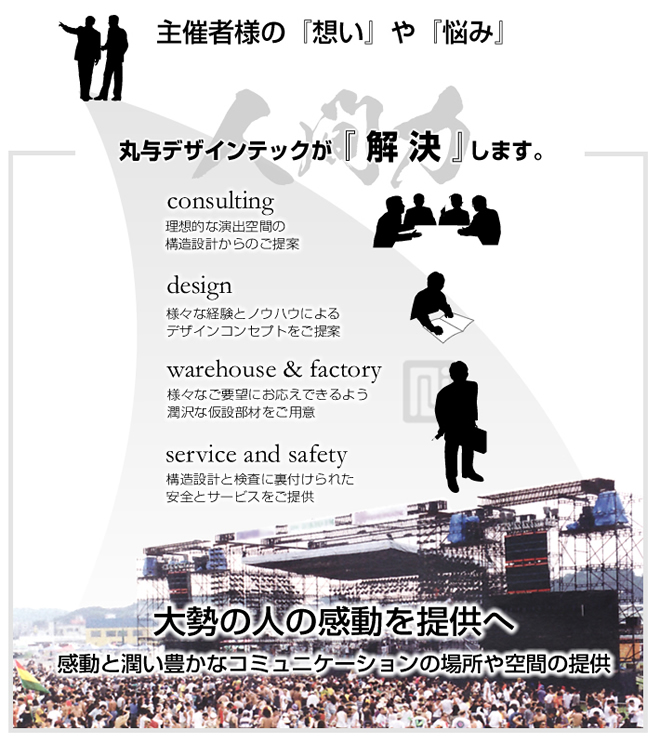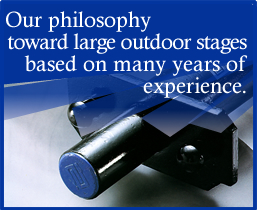In 1990, HAKI Maruyo DesignTec became the distributor in Japan for the Swedish company HAKI, and began importing and selling the HAKI modular system to the event stage industry.
Maruyo DesignTec has met the needs of its customers for temporary structures in various fields. In addition, we have gained experience through a wide variety of events throughout the country and we have familiarity with a large number of venues therefore we can provide knowledgable advice based on this foundation of experience.
Based on our thorough knowledge of this equipment, we can provide detailed drawings, parts lists, and total weight calculations. Upon request, we can also prepare presentations with 3D perspectives.
Beyond just providing equipment, with our vast experience and knowhow we can provide consulting inclusive of everything from design concepts to structural design proposals all with a focus on “safety and service”, and ultimately, “providing inspiration.”

Our Passion for the World of the Artist Expressed on Stage
The live stage is an expression of the world of artist’s music and dreams. We believe that it is our job to help bring shape to the world of these artists. We have taken great pride working with professionalism these last 20yrs locally and internationally supporting entertainment literally from behind the scenes.
When building stages, the single most important thing to us is safety. There are many things required of us such as construction, expression, and costs, but nothing takes precedent over safety. The performance ending safely and the audience going home with a chest full of excitement, that is the goal that we work steadily toward each day.
Production Process of Building a Safe Stage
Our first step in the construction of a safe stage begins with the proper selection of scaffold members. We will select and build with scaffold members that meet the usage requirements for large stages. There is the verification and analysis that there has not been an oversight or miscalculation of safety in the design.Then there is the strength testing and non-destructive testing of each member before we test build in the same fashion as the final build in order to further check safety.
In addition to the skeletal structure, there is a variety of production equipment and decoration equipment, truss, motors, floor systems, hydraulic systems, wiring, and moving equipment on the stage to aid in creating excitement for the audience. All of these must be set up with safety first and foremost.
Thereupon, we make the stage without taking away from the ideas and images, the world the artists and designers have conceived. For this reason we are always checking and testing as we proceed with our work.
- Ensuring Safety = During set up and take down, during the show, during emergencies, while using equipment, while using pyrotechnics, etc.
- Ensuring Safety = Seismic strength, wind strength, ensuring of construction strength during build and take down
- Knowledge of venue ceiling conditions nationwide = Height, width, loads of hanging double floors, load in conditions, etc
- Load out preparation with a thorough understanding of the specifics of the load out vehicles
- Understanding and making sure the load conditions of the vehicle are met
- Keeping everything within schedule and budget
(Alternative plans presented as soon as possible in event of difficulty meeting schedule and budget constraints)
Inherent Risks in Building Stages
Building a stage involves many people working together simultaneously in accordance with process control, so precise preparation is essential. Therefore onsite communication to work safely, segmentation of the work place, prohibiting work overhead of people, adhering to safety regulations all reduce risk to people and increase efficiency of the workplace.
In particular, large-scale outdoor stages always face the following risks and require extra care.
- Risks from weather and earthquakes = Extreme wind, temperatures, snow, lightning, or recurrent aftershocks from earthquakes during exhibition, etc
- Risks from human error = Working in hot or stormy weather, workers with inadequate skills, physical exhaustion, sleepiness, etc
For example the dangerous job of rigging heavy objects to be raised by crane requires a thorough understanding of structural limitations and is not possible without knowledgable experienced staff.
The addition of risks from extreme weather or earthquakes can also undermine safety and lead to accidents. Some examples of human factor risks are inexperienced younger staff, sleep deprived staff, health concerns of older staff, and unclear direction for placement.
The decision to abort a live performance in the event of unavoidable risk
Every measure must be taken to avert the risks of collapse or damage from typhoons, lightning, rain, and high-winds. In responding the important thing is to immediately reinforce strength, remove roof sheets and decorations effected by the wind, etc. In some cases it is necessary to make modifications or changes to the plan.
If the risk from the weather is great, if it poses a risk to guests or staff, it may be necessary to abort the performance. We will make the final decision.
Peace of mind from assured safety
The many risks have been eliminated, the stage has been completed safely, and the show commences. When we see the smiles of the audience we feel great joy and pride.
However when the curtain is closed after the grand finale the stage removal will commence immediately. The stage, a result of everyone’s combined talent and energy, is gone the following day and the venue is back to the way that it was. I feel a combination of relief and accomplishment from the safe completion and some pensiveness from the ephemeral nature of this work.
Through the experience gained over time from these shows, we hope to continue to create spaces where people communicate heart to heart and convey dreams and excitement to large audiences.














